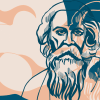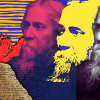A tribute to Akhtaruzzaman Elias on his 80th birthday

Born on 12 February 1943 Akhtaruzzaman Elias was much like a firework. His presence was short-lived but that took nothing away from how brightly he shone during his time. With only two novels and twenty-two short stories, he was far from being prolific. However, Khoabnama and Chilekothar Sepai, his two novels, are often mentioned with admiration amongst ardent readers. Elias built a multi-dimensional world in both of these novels; the epic-like compositions host the different classes of people that we see in society but what stands out most is the realism depicted in both of these books.
Definitely, his preferred approach to writing is the detailed depiction of reality. Reading his prose feels like one is present in the very scene in their physical form because of the way he successfully composed every individual scene in his novels. The characters were always memorable because they showed various colours.
His use of colloquial speech in the dialogues and the unashamed depiction of the physical world in all of its glory and ugliness, the flawed characters like real humans, and the wise use of important historical events like revolutions, yet unyieldingly making the story about something more than just the revolutions themselves, has given him a spot amongst the most influential fiction writers in Bangla literature.
In addition, what stood out about both of these novels is that there is no real closure in them. It's left for interpretation and up to the reader; inviting them into this intricately built dynamic worlds as if another character from the real would fit right in.
Another thing that elevated his prose was the use of political, sociological, psychological, historical, and even mythological themes. Combining such critical elements is a herculean task, even harder to do in a way that makes sense in the dimension of a fictional world. Yet, Akhtaruzzaman Elias did so with eloquence. That is probably why both of his novels can be expressed as less of fiction and more of a study of human nature and their dynamics in society itself.
Some people critique his work as 'difficult' and 'bombarded with complex ideas' but any realist will tell you that realism consists of both of those characteristics and Akhtaruzzaman Elias was very fond of depicting realism above all.
Other than his two novels, there are a few short story collections — Dojokher Om (The Warmth of Hell), Dudhbhate Utpat (No Peace in Milk and Rice), Onno Ghore Onno Shor (Another Tune in Another Room), Khoari (Hangover) and Jal Shopno, Shopner Jal (Fake Dream, Illusion of Dream). And an essay collection named Shongskritir Bhanga Shetu (Broken Bridge of Culture).
The author received numerous awards such as — Humayun Kabir Smriti Puraskar (1977), Bangla Academy Sahitya Puraskar (1983), Alaol Sahitya Puraskar (1987), Ananda Puraskar (1996), Sa'dat Ali Akhand Puraskar (1996), Kazi Mahbubullah Gold Medal (1996), and Ekushey Sahitya Padak (1999, posthumous). The novel Chilekothar Sepai was turned into a film, and several other of his works have been translated into other languages.
In his personal life, Akhtaruzzaman Elias was humorous, witty, eloquent, curious, and even a little bit sarcastic from time to time. He drew inspiration from his curiosity about even the mundane things in life. In his words, he used to get surprised by everything because even when he's seen something a hundred times, he discovers something new every time he encounters it. This might explain his keen interest in details and approach to description in his writing.
This 12 February, Akhtaruzzaman Elias would have been 80. His early demise deprived our literature of many masterpieces that he might have produced. We offer our tribute and recall him with great reverence in hopes that Akhtaruzzaman Elias gets the recognition that he deserves.

 For all latest news, follow The Daily Star's Google News channel.
For all latest news, follow The Daily Star's Google News channel. 








Comments